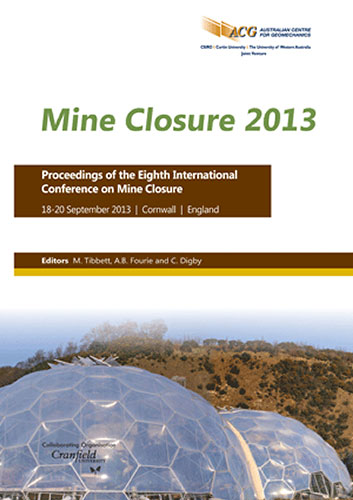Performance of Eucalyptus species on capped arsenic-rich gold mine tailings in the Victorian Goldfields, Australia

|
Authors: Sanchez-Palacios, JT; Doronila, AI; Baker, AJM; Woodrow, IE |
DOI https://doi.org/10.36487/ACG_rep/1352_27_Doronila
Cite As:
Sanchez-Palacios, JT, Doronila, AI, Baker, AJM & Woodrow, IE 2013, 'Performance of Eucalyptus species on capped arsenic-rich gold mine tailings in the Victorian Goldfields, Australia', in M Tibbett, AB Fourie & C Digby (eds), Mine Closure 2013: Proceedings of the Eighth International Seminar on Mine Closure, Australian Centre for Geomechanics, Cornwall, pp. 331-343, https://doi.org/10.36487/ACG_rep/1352_27_Doronila
Abstract:
An experimental tailings research facility was constructed to allow long-term trials to be conducted in order to investigate the performance and variation in growth and arsenic foliar content in 16 taxa of eucalypts comprising five Eucalyptus spp. with various provenances. A 30 cm deep cover of slurried oxide waste residue was poured on to consolidated arsenic-rich sulphidic gold tailings and was capped with a 10 cm layer of local topsoil. The Eucalyptus were planted in September 2008. The study reported here focusses on the growth responses of candidate Eucalyptus species and provenances in relation to substrate variables (cover depth and arsenic mobility). Three provenances of Eucalyptus cladocalyx grew the fastest and, on average, produced the largest stem volumes. The local provenance of E. goniocalyx was the poorest. Among the other species, Corymbia maculata with provenances from New South Wales and Western Australia (WA) ranked second, E. camaldulensis with provenances from Victoria, WA and South Australia ranked third, and E. tricarpa ranked after these. Owing to its ability to grow under arsenic-rich conditions, more detailed testing of E. cladocalyx involving long-term monitoring of growth, biomass partitioning and foliar arsenic content is required to improve the selection of suitable species and provenances for use in arsenical mineral waste rehabilitation.
References:
Anawar, H., Garcia-Sanchez, A. and Santa-Regina, I. (2008) Evaluation of various chemical extraction methods to estimate plant-available arsenic in mine soils, Chemosphere, Vol. 70(8), pp. 1459–1467.
Chang, P., Kim, J.Y. and Kim, K.W. (2005) Concentrations of arsenic and heavy metals in vegetation at two abandoned mine tailings in South Korea, Environmental Geochemistry and Health, Vol. 27, pp. 109–119.
Chen, T., Wei, C., Huang, Z., Huang, Q., Lu, Q. and Fan, Z. (2002) Arsenic hyperaccumulator Pteris vittata L. and its arsenic accumulation, Chinese Science Bulletin, Vol. 47, pp. 902–905.
Comino, E., Miller, B. and Enright, N.J. (2004) Soil seedbanks in natural and restored box-ironbark forests at Stawell Gold Mine, Victoria, Pacific Conservation Biology, Vol. 10, p. 9.
Craw, D., Rufaut, C., Haffert, L. and Paterson, L. (2007) Plant colonization and arsenic uptake on high arsenic mine wastes, New Zealand, Water, Air, & Soil Pollution, Vol. 179, pp. 351–364.
Dyke, G.V. (1988) Comparative Experiments with Field Crops, 2nd edition, Charles Griffin and Co. Ltd.
French, C.J., Dickinson, N.M. and Putwain, P.D. (2006) Woody biomass phytoremediation of contaminated brownfield land, Environmental Pollution, Vol. 141, pp. 387–395.
Hall, D.O., Scurlock, J., Bolhar-Nordenkampf, H., Leegood, R. and Long, S. (1993) Photosynthesis and Production in a Changing Environment: A Field and Laboratory Manual, Chapman & Hall, London.
Hartley, A. (1977) The establishments of Eucalyptus tereticornis on tailings from the Bougainville copper mine, Papua New Guinea, Commonwealth Forestry Review, Vol. 56.
Healy, M. (1951) Latin rectangle designs for 2n factorial experiments on 32 plots, Journal of Agricultural Science, Vol. 41, pp. 315–316.
King, D.J., Doronila, A.I., Feenstra, C., Baker, A.J.M. and Woodrow, I.E. (2008) Phytostabilisation of arsenical gold mine tailings using four Eucalyptus species: growth, arsenic uptake and availability after five years, The Science of the Total Environment, Vol. 406, pp. 35–42.
Krachler, M., Shotyk, W. and Emons, H. (2001) Digestion procedures for the determination of antimony and arsenic in small amounts of peat samples by hydride generation-atomic absorption spectrometry, Analytica Chimica Acta, Vol. 432, pp. 303–310.
Ma, L.Q., Komar, K.M., Tu, C., Zhang, W., Cai, Y. and Kennelley, E.D. (2001) A fern that hyperaccumulates arsenic, Nature, Vol. 409, p. 579.
Madejón, P., Marañón, T., Murillo, J.M. and Robinson, B. (2004) White poplar (Populus alba) as a biomonitor of trace elements in contaminated riparian forests, Environmental Pollution, Vol. 132, pp. 145–155.
Meharg, A.A. (2003) Variation in arsenic accumulation–hyperaccumulation in ferns and their allies, New Phytologist, Vol. 157, pp. 25–31.
Paine, C., Marthews, T.R., Vogt, D.R., Purves, D., Rees, M., Hector, A. and Turnbull, L.A. (2011) How to fit nonlinear plant growth models and calculate growth rates: an update for ecologists, Methods in Ecology and Evolution, Vol. 3, pp. 245–256.
Robinson, B., Schulin, R., Nowack, B., Roulier, S., Menon, M., Clothier, B., Green, S. and Mills, T. (2006) Phytoremediation for the management of metal flux in contaminated sites, Forest Snow and Landscape Research, Vol. 80, pp. 221–224.
Tlustoš, P., Száková, Ji., Vysloužilová, M., Pavlíková, D., Weger, J. and Javorská, H. (2007) Variation in the uptake of arsenic, cadmium, lead, and zinc by different species of willows Salix spp. grown in contaminated soils, Central European Journal of Biology, Vol. 2, pp. 254–275.
Vázquez, S., Agha, R., Granado, A., Sarro, M., Esteban, E., Peñalosa, J. and Carpena, R. (2006) Use of white lupin plant for phytostabilisation of Cd and as polluted acid soil, Water, Air, & Soil Pollution, Vol. 177(1), pp. 349–365.
Wang, H., Ye, Z., Shu, W., Li, W., Wong, M. and Lan, C. (2006) Arsenic uptake and accumulation in fern species growing at arsenic-contaminated sites of southern China: field surveys, International Journal of Phytoremediation, Vol. 8, pp. 1–11.
Wenzel, W.W., Kirchbaumer, N., Prohaska, T., Stingeder, G., Lombi, E. and Adriano, D.C. (2001) Arsenic fractionation in soils using an improved sequential extraction procedure, Analytica Chimica Acta, Vol. 436, pp. 309–323.
Zhao, F.J., McGrath, S.P. and Meharg, A.A. (2010) Arsenic as a food chain contaminant: mechanisms of plant uptake and metabolism and mitigation strategies, Annual Review of Plant Biology, Vol. 61, pp. 535–559.
© Copyright 2025, Australian Centre for Geomechanics (ACG), The University of Western Australia. All rights reserved.
View copyright/legal information
Please direct any queries or error reports to repository-acg@uwa.edu.au
View copyright/legal information
Please direct any queries or error reports to repository-acg@uwa.edu.au